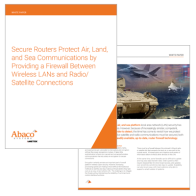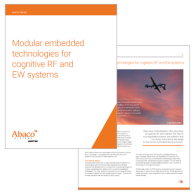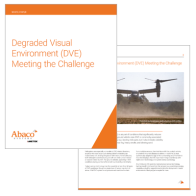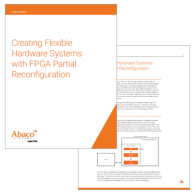Share
Share
Share
Share
Share
Share
Share
Search
White Papers
| Title: | Release Date | Description |
|---|---|---|
| Selecting a Bus Analyzer 101 | March 2016 | As Avionics buses on military and commercial aircraft become more varied and complex, a bus analyzer has become an important tool for use during integration, validation, deployment, and maintenance of avionics systems. Today's aircraft may contain MIL-STD-1553, ARINC 429, CAN, or ARINC 664 (AFDX) buses as part of the overall system. Choosing an analyzer needs to be a part of the overall system integration and test plan from the earliest phase of the project. |
| Anti-Tamper Technology: Safeguarding Today’s COTS Platforms | January 2016 | Secure embedded computer and communications systems are critical for mission success in today’s environment of escalating cyber threats. Data integrity must be protected as it is processed, stored, and transmitted. The strategic risk management of these systems is known as Information Assurance (IA), which entails a combination of physical, technical, and administrative controls. At the core of an assured system is an authentic, trusted foundation based on Anti-Tamper (AT) safeguards using layered security features at the hardware, firmware, and software level. Abaco Systems is responding to the need for assured systems by incorporating product features that enable anti-tamper safeguards. This paper focuses on the use of COTS anti-tamper frameworks to support secure platforms and provide information assurance. |
| GStreamer Optimized Multimedia Processing for Audio and Video | October 2015 | GStreamer is a platform-independent (Microsoft® Windows®, Linux®, Android™, OS X®, BSD, OpenSolaris) multimedia framework for constructing modular processing pipelines using an extensible plug-in architecture. Applications range from simple Ogg Vorbis playback and audio/video streaming to complex audio (mixing), video (non-linear editing) processing, metadata, subtitles and much more. Today, GStreamer is used in many open source applications including Totem, Rhythmbox and Songbird as well as being heavily utilized by the GNOME desktop environment under Linux. |
| Metadata Handling in Rugged Embedded Video Compression Systems | August 2015 | Video data handling in rugged embedded compu ng environments has an immensely varied range of applica ons and requirements. Developing products that enable the e ec ve handling of not just video, but also corresponding audio and metadata, is a signi cant challenge. |
| NVIDIA'S Tegra K1: A Game-Changer for Rugged Embedded Computing | July 2014 | GPU technology is already making significant inroads into applications such as radar, sonar and ISR that can readily benefit from the very high degree of parallelism offered by graphics processors. The extensive compute capability offered by GPU technology has, however, challenges with power consumption and heat dissipation – a concern in smaller, lighter weight platforms that do not have significant power at their disposal and that are problematic to cool. But: the limitations of deploying GPU technology in SWaP-constrained environments were largely eliminated when, earlier this year, NVIDIA® announced that Abaco Systems was its preferred provider of rugged solutions, destined for harsh, challenging environments, based on the Tegra® K1. |
| Beyond DVE: Options for Improving Situational Awareness | January 2014 | This paper explores options for closing the gap between natural vision and indirect vision in all conditions, allowing deployed forces to see, understand, and react to their surroundings in safety even when visual integrity is compromised. |
| Tuning HPEC Linux Clusters for Real-Time Determinism | October 2013 | This paper investigates interrupt response times and message passing latencies using OpenMPI on three different versions of the Linux kernel; one ‘standard’ server grade, one server grade with real-time pre-empt patches applied, and one with a proprietary, real-time kernel. In order to characterize these platforms, a series of measurements were made with and without a background CPU load. This paper will also highlight some system and Linux kernel tuning techniques that can improve determinism and affect system performance. The results are presented in a series of graphs showing histograms of interrupt response and MPI message latencies under the various workloads and tuning scenarios. |
| GPUDirect™ RDMA | March 2013 | GPUDirect RDMA solves an age-old problem for GPUs by removing the CPU and system memory bottleneck. By doing so, GPUDirect RDMA greatly decreases the latency of streaming data into the GPU from external PCIe endpoints and increases bandwidth through more efficient PCIe intercommunication. This allows the GPU to move into new application domains, like electronic warfare and radar/SIGINT frontends, which were previously inaccessible due to low-latency requirements. Learn how the latest generation of Kepler™-family GPUs and CUDA™ 5.0 from NVIDIA®, along with a new feature called GPUDirect™ RDMA enable 3rd-party PCIe endpoints to DMA directly to and from the GPU, without the use of system memory or the CPU. |
| Effective Video Handling on Unmanned Vehicles | December 2012 | This paper describes and illustrates some of the many applications for which the Abaco Systems ICS-8580 rugged video processor is an ideal solution. It has the flexibility and features to greatly ease the system integration burden by providing one platform that can be used in many different ways. The ICS-8580 and the standalone daq8580 are truly unique products in the rugged COTS market. The ICS-8580 and daq8580 are interchangeable for any of the applications cited in this document. Choosing which product should be used is simply a question of optimal system architecture when other processing needs are factored in. |
| Automated Target Tracking | July 2012 | This paper explores the ramifications of real-time autonomous vehicle performance in cluttered environments. It analyzes the gap between the predictable and the unpredictable, introduces real object tracing, explores the benefits and pitfalls of real-time moving object tracking and introduces possible solutions for uninterrupted operation of autonomous vehicles. |
| OpenVPX System Bandwidth | May 2012 | This paper compares the bandwidth available to two common types of dataflow for systems based on the VITA 65 CEN16 central switched topology, using three different fabrics – Serial RapidIO (SRIO), 10 Gigabit Ethernet (10GbE), and Double Data Rate InfiniBand (DDR IB). |
| RDMA: The Future of High Speed Fabric Interconnects | October 2011 | In 1999, a proposal for next-generation I/O was introduced by Intel®, Microsoft® and Sun Microsystems® (now Oracle®). The collective goal was to define an optimal server and storage architecture. The resulting specification, known as System I/O, was released in October 2000. Today, this is known as InfiniBand. This white paper will explore the merits of this architecture as well as methods of optimizing its use. |
| Vetronics Architectures Emerge to Facilitate Network-Enabled Operations | August 2011 | Battlefield communications capabilities have emerged as a top military priority. As a result, vehicle electronics (often combined as “Vetronics”) architectures are evolving to ensure that military assets can effectively serve as part of a holistic communications network. Our new white paper, Vetronics Architectures Emerge to Facilitate Network-Enabled Operations, reviews the genesis and implementation of the NEO paradigm, and explores how Vetronics architectures are changing communications among virtually all battlefield assets. |
| ATCA Blades, 6WINDGate Software Pair to Optimize Data Rate Throughput | June 2011 | As bandwidth needs increase throughout the telecommunications arena, the industry is being forced to look beyond 10Gbit/s data rates to 40 and even 100 Gigabit throughputs. Such high performance forces the use of acceleration features on the hardware as well as the use of bare metal operating systems to best-utilize all available processor cores. This white paper looks at the risks involved in the development of such systems, as well as how the use of Abaco Systems ATCA blades and 6WINDGate software can mitigate those risks. |
| Switched Fabrics Support High-Performance Embedded Computing for Military and Aerospace Platforms | June 2011 | This white paper explores how system integrators can leverage the switched fabric networking technologies found in HPC systems in the development of military and aerospace applications. |
| DSP Applications to Reap Benefits from Inclusion of AVX in Processors | May 2011 | This white paper looks at the potential impact that the addition of AVX technology in the 2nd Generation Intel Core i7 processors may have on DSP applications in the military and aerospace arena. |
| Recent Focus on 10Gbps Ethernet Driven by Heavy Demand for Video | May 2011 | This white paper looks at the rapid rise of 10 Gigabit Ethernet as the new default communications channel for military embedded computing. |
| Video Tracking Developments Afford Greater Range of Deployed Platforms | May 2011 | This white paper looks at the engineering benchmarks of video tracking systems in military and aerospace deployments, and how Abaco Systems video tracking devices meet those technological requirements. |
| COTS-Based Computer Systems Reduce Risks to System Developers | April 2011 | This white paper explores many of the avenues by which risk can enter a system development project, and how a standard COTS-based computer system can be used to advantage to reduce or even eliminate many potential risk issues. |
| Consumer Market Drives Advances in High-Performance Embedded Computing | April 2011 | This white paper looks at how the high-performance embedded computing (HPEC) segment of the military and aerospace market is benefiting from technological advances, and how system developers can best leverage the advantages being afforded them. |
| PCI Express Peer-to-Peer Interconnect | March 2011 | Its low latency, high bandwidth, widespread support and cost-effective silicon have made PCI Express ubiquitous. It can however, be used for more than merely communicating between a host and a peripheral: it has many advantages as a peer-to-peer communications technology. Enabling this, however, demands an understanding of how PCI Express works. This paper outlines the complexities that need to be understood and overcome – and describes a Abaco Systems software product that delivers a solution that masks those complexities from developers. |
| Latest Intel Processors, Chipset Provide Dramatic Embedded Improvements | February 2011 | The January 2011 release of the 2nd Generation Intel Core i7 processors, formerly code-named Sandy Bridge, provide the embedded military-aerospace computing arena with new opportunities for improved performance. The new dual-and quad-core processors, as well as the Intel 6 Series chipset, effectively double the potential computing and graphics capabilities within the same power envelope. In concert, these gains make the new Core i7 family even more attractive for use in military and aerospace platforms constrained in size, weight and power (SWaP). This white paper looks at how the 2nd Generation Intel Core i7 processors have the potential to dramatically improve embedded computing capabilities in a wide range of military and aerospace applications. |
| Embedded Computing Technologies for Unmanned Vehicles | August 2010 | The range of computing technologies required by unmanned vehicles is broad. The ability to capture and process video information in challenging environments. The ability to process sensor-acquired data. The ability to ensure robust communications onboard the vehicle and with a ground station. The ability to take autonomous action based on the data it acquires. Abaco Systems solutions for challenging military and aerospace applications feature many of those technologies. This white paper looks at some of the technology challenges that have to be overcome in order to maximize the effectiveness of unmanned vehicles. |
| Video Electronics Designed with the Unmanned Vehicle in Mind | May 2010 | This white paper describes some of the key considerations encountered during the development of the ICS-8580 rugged video streaming XMC board, with a particular focus on the selection of video codec, which is one of the critical decisions in any video streaming application. An analysis will be made of the two most common video codec’s, JPEG2000 and H.264 (MPEG-4 part 10) to determine which one is better suited to solving the demands for greater computing capability, ruggedness, power consumption, flexibility, and physical size limitations specifically with unmanned vehicles. |
| Packaging of Rugged COTS Systems | May 2010 | |
| Designing and Manufacturing Rugged COTS Assemblies | May 2010 | What to look for when designing and selecting a rugged COTS-based product. |
| ATCA Makes the Most of Multicore Processors | April 2010 | Our recently published white paper describes how ATCA takes advantage of multicore processors to deliver very high compute density, reliability and redundancy. For example, in compute-intensive applications, where a large number of processors must communicate with high throughput and very low latency, ATCA delivers. It also offers computing density — an ATCA system with 14 dual Intel® 6-core "Westmere" processors yields 168 cores within a single ATCA chassis. Communication applications, which likewise demand high throughput and efficient packet processing, also benefit from parallel processing which is where multicore technology shines. An ATCA communication system composed of two Ethernet hubs, two multicore processor blades, and up to 12 dual 16-core OCTEON Plus packet processor blades provides 320 MIPS64 cores (OCTEON devices) and 24 Intel® Westmere devices in one chassis. |
| The significance of Intel's Core i7 to embedded computing | February 2010 | The processors in Intel® Core® i3, Core® i5 and Core® i7 families included 12 targeted at embedded applications. These embedded processors have 7-year lifetime availability, which is a key feature for many embedded applications. This paper delves into their many other important features, including ECC memory, performance/watt and the integrated GPU. |
| Video Image Fusion for Real-Time Systems | January 2010 | |
| Long Term Support Strategies for Open Architecture COTS Assemblies | November 2009 | Programs are increasingly turning to COTS assemblies in order to gain timely access to the latest technology under favourable commercial terms. There is a potential downside though in that by design COTS building blocks utilize commercially available components, the availability of which is governed by wider market forces. As a result, in order to guarantee supply, it is vital that any COTS procurement is supported by a Long Term Support strategy appropriate to the program. In part this strategy has to mitigate, or even eliminate, the effects of obsolescence but it also has to address all factors required to support maintenance, repair and upgrades to fielded equipment. This paper will explore a range of techniques that when added together as part of a coherent strategy can provide Long Term Support tailored to program timescale and financial needs. |
| Real-Time Networking with Reflective Memory | September 2009 | A Reflective Memory network is a special type of shared memory system which enables multiple, separate computers to share a common set of data. Reflective Memory networks maintain an independent copy of the entire shared memory set in each attached system. Extremely low data latency is the key benefit of a high-speed, hardware-driven network like Reflective Memory. This low-latency performance is of paramount importance when building real-time systems such as simulators. |
| The Role of Packet Processors | September 2009 | Universal connectivity offers numerous advantages, but also introduces new risks and concerns such as network management, monitoring and security. Packet Processors are built specifically to deal with these issues. They offer several advantages over traditional network processors because their hardware and software is tailored for packet movement, which gives them the ability to perform at multi-gigabit line rates. |
| Technical Needs and Challenges in Harbor Surveillance | May 2009 | High frequency sonar applications are not a new concept. Navies of the world have been using high frequency sonar to seek out mines for the past sixty years. More recently however, a growing imperative to counter terrorist threats to harbors and coastal areas has created the need for a new range of high frequency sonar products, designed to detect and track specific surface and underwater targets such as divers, swimmers and water vehicles. As a consequence, COTS vendors of acquisition products have been forced to re-examine, and in some cases redesign, existing technical solutions to cope with the very demanding requirements of these applications. Click on the attached white paper to read the newest approaches to acquire and process high frequency sonar signals and the benefits over older traditional approaches. |
| Switched Ethernet Latency Analysis | February 2009 | |
| Advances in Radar Processing | February 2009 | With radar systems, as with many other military applications, it is difficult to determine whether the requirement for greater processing capability has driven the development of more powerful hardware and software – or whether radar systems designers have been quick to perceive the opportunities presented by more capable hardware and easier-to-use software. Whichever is the case, it is certainly true that today’s sophisticated radar processing is reliant on three key elements. Click on the white paper link to learn more about the three key elements in which today’s radar processing systems rely on. |
| TS-MPEG4 Video Compression Application Concepts | January 2009 | This white paper examines how to leverage the MPEG-4 PMC in a distributed ISR environment potentially involving a UAV. The real-time video compression and transmission solution, with dynamic distribution control, provides the ability to adjust video quality and redirect the compressed stream in mid-flight. Click on the attached white paper as these features are shown to be indispensable in the scenario discussed. |
| High-Speed Data Acquisition for Medical Imaging Utilizing SDR Technology | December 2008 | New medical technologies often hold great promise, but few patients will benefit unless an effective implementation can be brought to market at a reasonable cost. One of the most cost effective ways of developing new solutions is to leverage techniques and equipment developed for other purposes. Medical ultrasound, which borrows heavily from naval sonar, is probably the best known example, but other technology developed for military purposes is also being adapted to medical uses. With the introduction of Abaco Systems ICS-1650, developers of PC-based medical imaging systems now have a native PCI Express slot card that provides high performance signal acquisition capability with leading edge FPGA based DSP resources, at a very reasonable price. |
| DSP Libraries and Graphical Tools Accelerate Distributed Corner Turn Development | March 2008 | Virtually every radar application requires many FFTs on a set of radar pulse returns. The FFTs are normally performed in fast time dimension (row data) or in the slow time dimension (column data). However, mathematical operations performed on column data are normally very slow as column data is not contiguous in memory. This means that streaming accesses are not available, and SDRAM pages may need to be opened and closed; it is therefore faster to perform a matrix transpose or “corner turn” on the column data then process the slow time dimension FFTs on rows of data. This matrix transpose operation is extremely straightforward if the FFT processing is performed with a single embedded processor. However, real-time constraints usually mandate the use of multi-computers where the data flow and processing are much more complicated. This white paper will show how DSP libraries and graphical tools accelerate this distributed corner turn development. |
| Software Strategies for Leveraging VXS Technology | December 2007 | Switched fabrics have been around for several years now, but with the advent of platforms such as ATCA, MicroATCA, VXS and VPX, their use is set to be ubiquitous. No longer is the fabric connection an afterthought, shoehorned into an architecture that was never designed to support such throughput, but it is now an integral part of the architecture, allowing for interconnects that are balanced with compute power now available with multi-gigahertz clock speeds and multiple cores. |
| Ethernet Switching | April 2007 | In recent years Ethernet and Internet Protocol (IP)technologies have made their way from commercial networks into telecommunications and military networks. Although Ethernet is the most popular communication protocol, it has some considerable shortcomings when applied to these challenging environments. However, network architects are willing to adapt to or work around Ethenet's limitations, and embedded switching is a useful tool in tyhis process. This paper is intended to introduce you to: • Basics of data transmission using Ethernet and IP • Concepts of network layers • Layer-2 switching • Layer-3 switching • Protocols that typically run on Ethernet and IP switches • Redundancy and failover – a critical subject for both military and telecommunication applications. • Applicable examples |








